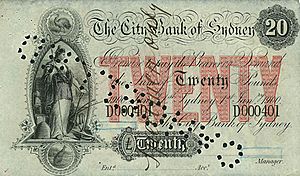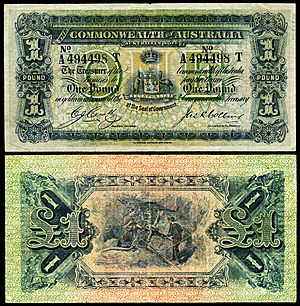History of Australian currency facts for kids
Before Europeans arrived, Australia's first people traded things like tools, food, and stories. They didn't use money like coins or notes. When British settlers came on January 26, 1788, they brought English money to the new colony of New South Wales. But there wasn't enough of it, so people had to find other ways to trade. Australia got its own national money in 1910, called the Australian Pound. Later, in 1966, it changed to the Australian Dollar, which uses cents, just like money in many other countries.
For a long time, the value of Australian money was linked to the British pound. After 1971, it was linked to the United States dollar. Then, in 1983, Australia decided to let its money's value float. This means its value changes freely based on how much people want to buy or sell it around the world.
Contents
Money in Early Australia
The first European settlement in Australia began on January 26, 1788, at a place called Port Jackson (which is now Sydney, New South Wales). The British government made a big mistake by not sending enough coins for the new colony. In 1790, a ship brought about 4,500 Spanish dollars. But these dollars quickly left the colony because they were used to pay for goods from visiting ships.
Life was very hard in New South Wales for the first 25 years. The British government was busy with wars in Europe, like the Napoleonic Wars, so they didn't pay much attention to Australia. Because there wasn't enough official money, people often used rum to buy and sell things. Army officers, known as the "Rum Corps", controlled the rum supply. This made them very powerful and rich.
Many different foreign coins were used in the colony. In 1800, Governor Philip Gidley King tried to fix things by saying how much each foreign coin was worth. But this didn't solve the problem. The "Rum Corps" even removed Governor William Bligh from power in 1808 in what was called the "Rum Rebellion". This happened partly because they wanted to keep control of the rum trade. The shortage of coins continued for a long time. For example, between 1811 and 1816, Governor Lachlan Macquarie paid builders of the Sydney Hospital with large amounts of rum.
The first coins made in the colony appeared in 1813. Governor Macquarie ordered that the middle of 10,000 Spanish dollars be punched out. This created two new coins: a small "dump" and a ring-shaped "holey dollar". A holey dollar was worth five shillings, and a dump was worth one shilling and three pence. The idea was to make these coins useless outside New South Wales so they would stay in the colony.
In 1817, the first bank, the Bank of New South Wales, opened. It printed its own bank notes, which were like paper money. These notes were widely used, even though people didn't have to accept them as official money.
In 1825, the British government decided to send British money to all its colonies. This was because Britain had started using a gold standard for its money in 1816. Also, there were fewer Spanish dollars available because of wars in South America where they were made. So, in December 1825, £30,000 worth of British coins were sent to New South Wales. The government encouraged people to use these British coins by slowly reducing the value of the Spanish dollars. By the mid-1830s, British money was commonly used.
In 1852, after gold was found in Australia, the Government Assay Office in Adelaide made gold pound coins. These coins were a bit heavier than British gold coins called sovereigns. Later, the Royal Mint (which makes British coins) opened branches in Australia. The Sydney Mint opened in 1854, and the Melbourne Mint started making coins in 1872. Many gold sovereigns made in Australia were meant for use in India, but India mostly stuck to its own money system.
Money Before Australia Became a Nation
When Australia became a nation (federated) in 1901, and for a while after, different types of money were used. People used British silver and copper coins, and gold sovereigns made in Australia. There were also copper "trade tokens" and private bank notes from different banks. The government of Queensland even issued its own notes for a time. The Perth Mint opened in 1899, where gold miners could exchange their raw gold for gold coins.
Australia's Own National Money
In September 1910, the Australian government, led by Prime Minister Andrew Fisher, took control of money matters. They passed the Australian Notes Act, which created Australia's own national money: the Australian pound. Just like the British pound, the Australian pound was divided into 20 shillings, and each shilling had 12 pence. So, one pound was worth 240 pence. This law also stopped states from printing their own money and made the Commonwealth Treasury in charge of printing Australian notes.
For the first three years, the government used blank notes from 16 different banks. They printed over them to make them the first Commonwealth notes. New designs for Australia's first official government banknotes were ready in 1913.
Another law passed in 1910, the "Bank Notes Tax Act", put a very high tax on any private bank notes. This effectively stopped banks from printing their own money in Australia.
In 1920, the government moved the power to print notes from the Treasury to the Commonwealth Bank. Later, in 1960, the Reserve Bank of Australia took over this job. Since 1988, the Reserve Bank has been making Australia's special polymer banknotes, which are made of plastic. The part of the bank that prints notes became a separate company called Note Printing Australia in 1998.
At first, the Australian pound had the same value as the British pound sterling. Australia was on the gold standard as long as Britain was. This meant the value of the money was linked to gold. In 1914, the British pound was no longer linked to gold. Australia returned to the gold standard in 1925, along with the United Kingdom. This made the Australian pound's value go up suddenly, which caused prices to fall (deflation). This had big effects on the economy. In 1929, during the Great Depression, Australia stopped linking its money to gold. This made the Australian pound worth less compared to the British pound.
During World War II, Japan printed special money, some in Australian pounds, for countries they planned to take over. Australia was never taken over, so this money wasn't used here. But it was used in parts of Papua and New Guinea, which were Australian territories at the time.
In 1949, when the United Kingdom made its pound sterling worth less against the US dollar, Australian Prime Minister Ben Chifley did the same for the Australian pound. This was to make sure Australian goods were still affordable for countries that used British money, as Australia traded a lot with them.
Changing to Decimal Money
In February 1959, the Australian government set up a committee to look into changing to a decimal currency system. This means a system based on tens, like dollars and cents. The committee suggested changing in February 1963. The government agreed in July 1961 and set February 1966 as the target date.
On February 14, 1966, the Australian pound was replaced by the Australian dollar. The change-over rate was simple: 1 Australian pound became 2 Australian dollars. One dollar was divided into 100 cents. This meant 10 shillings became $1, and 1 shilling became 10 cents.
It was a bit tricky for amounts less than a shilling because the old system used 12 pence to a shilling. For example, 6 pence became 5 cents.
When the change to decimal money was planned, many names were suggested for the new currency. In 1963, the Prime Minister, Robert Menzies, wanted to call it the royal. Other ideas included the austral, oz, boomer, roo, kanga, emu, koala, digger, zac, kwid, dinkum, and even ming (Menzies' nickname). Menzies' choice, the royal, was even printed on trial designs. But the name royal was very unpopular. People didn't like it at all! So, on September 18, 1963, the government announced that the new currency would be called the dollar, divided into 100 cents.
The Australian Dollar Today
When Australia's money was linked to the British pound, 1 Australian dollar was worth 8 British shillings. In 1967, Australia stopped linking its money to the British pound. Instead, in 1971, the Australian dollar was linked to the United States dollar at a rate of A$1 = US$1.12.
Since 1969, the Royal Australian Mint in Canberra has made all Australian coins. Before that, the Mints in Melbourne and Perth were part of the Royal Mint (British).
On December 12, 1983, the government, led by Prime Minister Bob Hawke and Treasurer Paul Keating, decided to let the Australian dollar float. This means its value is now decided by the world's money markets, based on supply and demand. Since then, the Australian dollar's value has gone up and down. It was as low as 47.75 US cents in April 2001 and as high as US$1.10 in July 2011.
On September 27, 2012, the Reserve Bank of Australia announced plans to update the banknotes. The new notes have better security features and include Braille dots to help people who are visually impaired. The first new banknotes (the $5 note) were released on September 1, 2016, and other notes followed in the next few years.
Images for kids
See also
Sources




